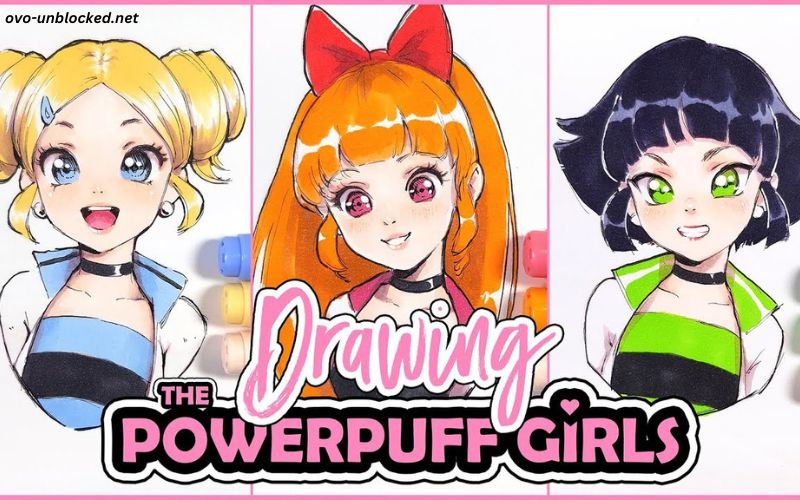In the vast landscape of animated television, few franchises have managed to capture the hearts of multiple generations like The Powerpuff Girls. Originally created by Craig McCracken and debuting on Cartoon Network in 1998, this series became an instant classic with its blend of action, humor, and charm. However, as the anime boom swept across the globe in the early 2000s, it was inevitable that this American series would eventually cross paths with Japanese animation, resulting in an intriguing reimagining: Anime= Powerpuff Girls.
Genesis of the Original Powerpuff Girls
Before delving into the anime adaptation, it’s essential to understand the cultural impact of the original Powerpuff Girls series. Set in the fictional city of Townsville, the show follows three kindergarten-aged girls—Blossom, Bubbles, and Buttercup—who were created in a lab accident by Professor Utonium. Each of the girls has her own unique powers and personality traits, with Blossom being the brainy leader, Bubbles the sweet-hearted one, and Buttercup the tough and rebellious sister. Together, they protect Townsville from a rogue’s gallery of villains, most notably the evil chimpanzee, Mojo Jojo.
The show’s appeal lay in its combination of simple, yet dynamic, animation with storylines that mixed child-friendly themes with subtle satire and pop culture references. This blend made it accessible to both younger audiences and adults, leading to a massive following and a legacy that included spin-offs, merchandise, and even a feature film.
The Birth of an Anime Adaptation
As anime gained international prominence, Western studios began to explore the idea of adapting their popular franchises to fit the anime mold. This led to the creation of Powerpuff Girls Z, a Japanese anime version of the series that aired in 2006. However, Anime= Powerpuff Girls represents a different, more modern approach to adapting the beloved series.
The exact origins of Anime= Powerpuff Girls are shrouded in some mystery, with rumors suggesting it started as a fan project that gained traction online before being picked up by a Japanese animation studio. What is clear, however, is that this anime adaptation takes significant creative liberties while still maintaining the core elements that made the original show a success.
Plot and Character Changes
In Anime= Powerpuff Girls, the familiar characters undergo some notable transformations. While the core trio—Blossom, Bubbles, and Buttercup—remains central to the story, their designs, personalities, and backstories are reimagined to better fit the anime aesthetic.
- Blossom: In this version, Blossom takes on a more serious and strategic role. She is depicted as a young girl prodigy, balancing her school life with her duties as a superhero. Her character is more introspective, with an emphasis on leadership and the pressures it entails.
- Bubbles: Bubbles retains her sweet and bubbly personality but with added depth. The anime explores her inner struggles, particularly the challenges of maintaining her optimistic outlook in the face of overwhelming evil. Her character design is more mature, reflecting her growth throughout the series.
- Buttercup: Buttercup’s tough exterior is given a darker edge in Anime= Powerpuff Girls. She is portrayed as a lone wolf, often struggling with her place within the group. Her rebellious nature is amplified, making her a more complex and sometimes tragic figure.
The Professor, too, undergoes changes. Rather than the bumbling yet well-meaning father figure from the original series, he is depicted as a brilliant, if slightly aloof, scientist whose creations have unforeseen consequences. His relationship with the girls is more distant, adding a layer of emotional complexity to the story.
Aesthetic and Stylistic Shifts
One of the most striking differences between the original Powerpuff Girls and Anime= Powerpuff Girls is the visual style. While the original show was known for its minimalist design and vibrant color palette, the anime adopts a more detailed and nuanced approach. The characters are rendered in the typical anime style, with larger eyes, more detailed facial expressions, and intricate costume designs.
The city of Townsville is also transformed. Instead of the simple, cartoonish setting of the original, the anime presents it as a sprawling metropolis with a mix of futuristic and dystopian elements. This change in setting reflects the darker and more mature tone of the anime.
Themes and Tone
The original Powerpuff Girls balanced light-hearted fun with occasional moments of genuine peril. However, Anime= Powerpuff Girls leans heavily into darker, more complex themes. The anime explores the psychological toll of being a superhero, particularly on young girls who must balance their powers with their desire for a normal childhood. The show delves into themes of identity, responsibility, and the consequences of violence, making it a more introspective and, at times, somber series.
The villains in the anime are also more nuanced. While Mojo Jojo remains a key antagonist, his character is given a tragic backstory that explains his obsession with the Powerpuff Girls. Other villains are introduced with similarly complex motivations, making them more than just one-dimensional threats.
Cultural Reception and Impact
Anime= Powerpuff Girls has garnered a mixed reception, reflecting the challenges inherent in adapting a beloved franchise. On one hand, the anime has been praised for its bold reimagining of the source material, with fans appreciating the deeper character development and more sophisticated storytelling. The darker tone and mature themes have resonated with older fans who grew up with the original series, offering them a version of the show that reflects their own growth.
However, some purists of the original series have criticized the anime for straying too far from what made The Powerpuff Girls so special. They argue that the show’s charm lay in its simplicity and humor, elements that are less prominent in the anime adaptation. The shift in tone and style has also alienated some younger viewers who prefer the light-heartedness of the original series.
Despite these criticisms, Anime= Powerpuff Girls has found a dedicated fanbase, particularly among anime enthusiasts who appreciate the fusion of Western and Eastern storytelling traditions. The show has sparked discussions about the broader implications of cross-cultural adaptations and the challenges of staying true to the spirit of the original while also creating something new and innovative.
Merchandise and Spin-offs
Like its predecessor, Anime= Powerpuff Girls has inspired a range of merchandise, from action figures and posters to clothing and accessories. The characters’ new designs, in particular, have proven popular among fans, leading to collaborations with various fashion brands and artists.
Additionally, there have been rumors of a potential spin-off series focusing on the backstories of some of the villains, as well as a possible crossover with other popular anime series. These developments highlight the ongoing interest in the franchise and its potential for further expansion.
Conclusion
Anime= Powerpuff Girls represents a fascinating chapter in the ongoing story of the Powerpuff Girls franchise. By reimagining the characters and their world through the lens of anime, the creators have crafted a series that both honors the original and pushes the boundaries of what a Powerpuff Girls story can be. While it may not appeal to everyone, it stands as a testament to the enduring appeal of these iconic characters and the possibilities that arise when different cultures and storytelling traditions intersect.
As the anime continues to attract new fans and spark conversations, it is clear that the Powerpuff Girls’ journey is far from over. Whether through further adaptations, spin-offs, or entirely new stories, Blossom, Bubbles, and Buttercup will undoubtedly continue to inspire and entertain audiences for years to come.

